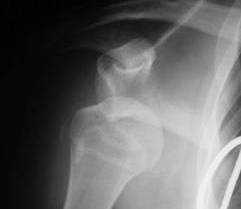QUESTION | | Surgical treatment of the unstable shoulder – How do you decide which patient gets what operation?
We know that younger patients and those doing sport that dislocate their shoulder are likely to do so again. Having more than 2 dislocations leads to a higher likelihood of arthritis developing in the shoulder. While it is generally clear that a patient requires surgical stabilisation of the shoulder it can be less clear which operation is best for them.
In broad terms the procedure can be performed arthroscopically or open. There are advantages and disadvantages to both approaches.

Arthroscopically you can achieve a labral repair, capsular plication, Remplissage (suturing the infraspinatus into the Hill Sachs lesion) or a combination of these. Open surgery can take the form of a labral repair, capsular shift or a bone transfer procedure (whether it be locally like a Laterjet or remotely like an Iliac crest bone transfer).
Arthroscopic stabilisation of the shoulder has a very low complication rate with a very high level of return to sport (close to 90%). It is the operation of choice for most people who dislocate their shoulder.
The results of arthroscopic surgery are much worse in contact athletes so my treatment paradigm is broadly divided into patients who participate in contact sports (Rugby, AFL, Boxing, Basketball, Ice Hockey etc) and those who do not. The exception to this is a very high level contact athlete in the early part of their season.
Re-dislocation rates after arthroscopic surgery are as low as 4% and as high as 25% depending on the individual patient. The re-dislocation rate of an arthroscopic stabilisation depends a great deal on which sport the person returns to, with a higher percentage of redislocation in collision athletes and younger patients (under the age of 18). The failure rates are also higher in the presence of a Bony Bankart lesion, ALPSA lesion and significant Hill Sachs lesion. Certain operations are not safely performed arthroscopically, such as a HAGL repair.
Open Surgery: If the patient is likely to re-dislocate with an arthroscopic operation we then change to performing open surgery for them. The next decision is whether to perform an open capsular shift or a bone transfer operation.
Laterjet: The Laterjet procedure (coracoid bone transfer) was designed to treat patients with significant glenoid bone loss and shoulder instability.
Recently there has been a considerable shift towards doing a Laterjet procedure as the patient’s first operation, even without bone loss. While this operation will certainly stop the shoulder from physically dislocating it does not necessarily cure the patients sensation of the shoulder moving excessively because it does not address the issue of capsular laxity that caused the problem in the first place. In many cases this operation is being used for contact athletes, despite them not having any significant bone loss (which is not what the operation was originally designed for).
The complication rate for a Laterjet procedure has been documented to be far higher than an open capsular shift. Complication rates of 12% (and higher) are often quoted, varying from permanent nerve injury, through failure to heal of the bone and hardware complications such as damage to the humeral head from the screws. If this operation fails there are not many options left to salvage the shoulder.
Over the last few years it has become clear that if a Laterjet is performed where the patient does not have any bone loss then the bone graft will reabsorb and disappear because it is not being loaded. This leaves the screws used to hold it in place very prominent and likely to create damage to the humeral head.
Open Stabilisation
An open stabilisation and capsular shift does have the disadvantage of taking down and then repairing the subscapularis muscle. It is possible to create some fatty degeneration in the subscapularis muscle belly but this does not seem to create much in the way of functional limitation for the patient.
The advantage of this operation is that allows the labrum to be repaired and the stretched out capsule to be tightened. The success rate of this operation is very high with a very low re-dislocation rate, even in contact athletes.
Decision Making:
The factors to consider are:
- Age
- Contact athlete
- Labral Tear
- SLAP lesion alone
- Capsular stretch without labral tear
- Mild damage
- Significant bone damage
- Significant damage to the humeral head as well
My approach:
1. No contact athlete with a labral tear:
1) Arthroscopic stabilisation + posterior capsule plication +/- Remplissage
i. HAGL lesion – Open repair
2. Contact Athlete with a labral tear
1) Open stabilisation
i. If Posterior labral tear only – Arthroscopic Repair
ii. In season professional wanting to play again early but accepting a slightly higher re-injury rate – Arthroscopic stabilisation with posterior capsular plication and rotator interval closure– May need formal open repair later
3. SLAP lesion – Arthroscopic Repair
4. Instability without labral tear
1) MDI / Non contact – Arthroscopic capsular plication
2) Contact / Very Active Sports or Work / HAGL – Open Capsular Shift
5. Mild Bone Damage
1) Non Contact – Arthroscopic repair with Remplissage
2) Contact / Very Active Sports or Work / HAGL – Open Capsular Shift
6. Significant Bone Damage
1) Laterjet Procedure
7. Younger Patient
1) Usually male and often contact sports – Open Stabilisation
Recurrent shoulder instability is very common. These days we are operating earlier to try to prevent arthritis developing in the shoulder caused by multiple dislocations. It is important to assess the individual and their imaging before deciding which operation is appropriate for them.
Remember that there is more than one type of open surgery available to the patient. An open stabilisation has a very high success rate and far fewer potential complications than a Laterjet procedure. Arthroscopic surgery will still be used the majority of the time.

